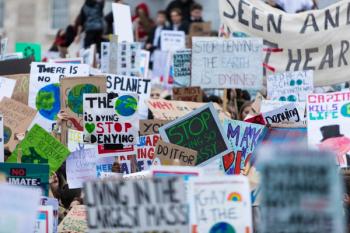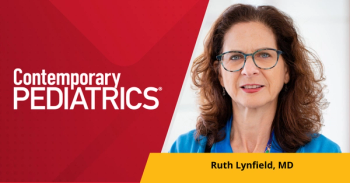
Climate change has adverse effects on children’s health
Children are more physiologically and developmentally vulnerable to health problems created by climate change.
The climate crisis is affecting everyone, but no group has more at stake than children. That was the key message of Debra Hendrickson, MD, at the recent American Academy of Pediatrics (AAP) 2019 National Conference and Exhibition in New Orleans, Louisiana. Her talk, “A burning house: Children’s health in the warming world,” addressed conference attendees during the plenary session on Monday, October 28.
Hendrickson told the audience that she was inspired to write a book on the need for action after seeing how climate change was affecting her patients in Reno, Nevada, which in 2016 was named the fastest-warming city in the United States. From infants suffering from wildfire smoke to teenagers anxious about their future in a warming world, children are increasingly feeling the impacts of our changing climate, she said.
Hendrickson urged doctors to better recognize how certain illnesses-such as asthma, allergies, heat illnesses, and infectious diseases carried by ticks and mosquitoes-are being amplified by rising temperatures, more frequent wildfires, hurricanes, flooding, and other climate changes.
“Although the health consequences of climate change are being seen in our patients,” she said, “clinicians may not notice because, much like natural disasters themselves, these diagnoses have always been around but they’re occurring now with greater frequency or severity.”
As part of her talk, Hendrickson told the stories of several children affected by wildfires, hurricanes, or heat waves, and then used their cases to explain why children are more physiologically and developmentally vulnerable to the health problems created by climate change. She emphasized the importance of such storytelling in motivating parents and policymakers to act, arguing that the climate crisis is not just a global crisis, it’s also “a very personal crisis, multiplied many times.”
Hendrickson noted that, ironically, pediatricians today have extraordinary new medications and technology to keep their patients healthy, while at the same time children are facing an existential crisis. “Climate change is threatening everything we work to accomplish for our patients because it is altering the fabric of life itself,” she said.
Far from being a pessimist, Hendrickson emphasized the great potential for pediatricians, as trusted sources of information, to help promote solutions and lead the way, both in their practices and their daily lives. She noted that there are relatively easy steps that each person can take to reduce their own carbon emissions and build a broader movement toward sustainable energy.
For example, most utility companies now offer a “green energy” option that allows customers to choose all-renewable electricity with just a few clicks on their website. Wider adoption of electric cars, which can plug into these all-green homes, and reducing meat and dairy content in our diets would also help, Hendrickson said.
Finally, noting that children are rising up in protest around the world, demanding that governments and corporations act on this issue while there is still time, she called on pediatricians to stand with them.
“We care for the generation that will be most affected by this crisis,” Hendrickson said. “We have a moral obligation to fight for our patients.”
COMMENTARY
Pediatricians are increasingly facing a new issue in child health-climate change. More extreme heat is increasing the risk of heat illness and making it more hazardous for children to play outdoors. Increasing wildfires and rising pollen counts are challenging our ability to protect children’s respiratory health. Warming winters, earlier springs, and higher water temperatures are causing shifts in patterns of some climate-sensitive infectious diseases.
Whereas all people are affected by changing climate conditions, children are among the most vulnerable. It is estimated that children aged younger than 5 years bear greater than 80% of the global burden of disease caused by climate change. In recognition of this unique vulnerability, the American Academy of Pediatrics (AAP) was the first major medical society to publish a policy statement on this topic in 2007. The AAP Council on Environmental Health published an updated policy statement and technical report in 2015. These reports identify climate change as one of the greatest threats facing children in the United States and across the world.
Although most pediatricians are seeing affected children today, recognizing the signal of climate change in a busy pediatrician’s office remains challenging. That is because changing patterns in temperature, rainfall, and extreme weather generally amplify and shift conditions pediatricians have always seen, rather than create novel conditions. Noticing changes in seasonal timing, frequency, or severity of common conditions can be a challenge.
In her plenary session at the AAP’s 2019 National Conference, Dr. Debra Hendrickson helped pediatricians to make the connections between changes in the climate and changes in the health of their patients. Through the stories of children affected by extreme heat, weather disasters, and wildfires, she portrayed how changes in climate are affecting the lives of real children in diverse ways across the United States. Many pediatricians are witnessing similar stories but have not yet linked them to environmental change.
Climate change is not only an immediate health threat but is an unprecedented risk to children’s future. As such, it is a moral challenge for all who care for children.
The past year has brought this into focus as children across the world have engaged in school strikes to highlight the urgent need for climate solutions to protect their future. In the United States, children are suing the federal government for its inaction on climate change and the resulting depravation of their fundamental rights in the case of Juliana v. United States. The AAP signed an amicus brief in support of the children in this case.
Advocacy has been a top priority of the AAP since its inception. The voice of pediatricians has been instrumental in protecting children from a wide range of threats to their health and safety over the century. Dr. Hendrickson discusses the role of pediatricians in speaking out in support of climate solutions. From small changes in our personal lives and practice management, to advocacy in our communities, states, and our nation’s capital, pediatricians can protect every child by working to ensure a safe and healthy planet for their future.
Samantha Ahdoot, MD, FAAP, is a pediatrician in Alexandria, Virginia, and assistant professor of Pediatrics at Virginia Commonwealth University School of Medicine, Inova Campus, Falls Church, Virginia. She serves on the Executive Committee of the American Academy of Pediatrics (AAP) Council on Environmental Health and was lead author of the AAP’s policy statement and technical report “Global climate change and children’s health,” published in 2015.
Newsletter
Access practical, evidence-based guidance to support better care for our youngest patients. Join our email list for the latest clinical updates.














